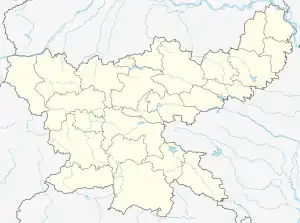| Navratangarh | |
|---|---|
 Navratangarh fort | |
| Location | Sisai, Gumla, Jharkhand, India |
| Coordinates | 23°06′36″N 84°47′01″E / 23.10993°N 84.78367°E |
| Area | 11 ha (27 acres) |
| Built | c.1636 - 1639 CE |
| Architect | Durjan Shah |
 Location in Jharkhand, India, Asia  Navratangarh (India) | |
Navratangarh (Doisagarh) was one of the capitals of the Nagvanshi dynasty, who ruled parts of what is now the state of Jharkhand, India. It is located in Sisai block of Gumla district. It is said that king Durjan Shah shifted his capital from Khukhragarh to Navratangarh.[1] He constructed the fort between 1636 and 1639.[2][3][4][5] The palace was a five-storeyed structure with its "water-gate" and garh-khai (moat) arrangement. It has a kiaclmy (court), a treasury house and a prison-cell with its underground dungeon.[6] [7][8] It was declared national heritage in 2009.[9][10]
Geography
M: municipality, CT: census town, R: rural/ urban centre, H: historical/ religious centre, T: tourist centre, B: Bauxite mining centre
Owing to space constraints in the small map, the actual locations in a larger map may vary slightly
Location
The fort is located in Sisai block of Gumla district. It is located in around 30 km from Gumla and 75 km from Ranchi.[2][3]
Area overview
The map alongside presents a rugged area, consisting partly of flat-topped hills called pat and partly of an undulating plateau, in the south-western portion of Chota Nagpur Plateau. Three major rivers – the Sankh, South Koel and North Karo - along with their numerous tributaries, drain the area. The hilly area has large deposits of Bauxite. 93.7% of the population lives in rural areas.[11][12]
Note: The map alongside presents some of the notable locations in the district. All places marked in the map are linked in the larger full screen map.
History
It is said that king Durjan Shah shifted his capital from Khukhragarh to Navratangarh.[1] He constructed the fort between 1636 and 1639 CE. After his release from Mughal captivity, the Raja decided to build the fort. Navratangarh was in a strategic location as it was surrounded by forests, hills and rivers.[7][13] King Ram Shah built Kapilnath Temple in 1643. He succeeded by Raghunath Shah. He also built several temples. Yadunath Shah shifted capital to Palkot due to Mughal invasion.[14]
References
- 1 2 "वास्तुशिल्प और स्थापत्य कला का अद्भुत उदाहरण है सिसई का कपिलनाथ मंदिर". hindusthansamachar. 2 October 2021. Retrieved 28 September 2022.
- 1 2 "Eye on Nagvanshi remains - Culture department dreams of another Hampi at Gumla heritage site". telegraphindia. 7 May 2009.
- 1 2 "Treasure of history lies unattended in Gumla". dailypioneer. 12 January 2017.
- ↑ "Gumla City History-Importance-Origin-Architecture". hoparoundindia. Archived from the original on 15 April 2016. Retrieved 12 March 2019.
- ↑ "The Lost Kingdom of Navratangarh". indianvagabond. 5 February 2015.
- ↑ "The Nagbanshis And The Cheros". archive.org. 1969.
- 1 2 "Seat of Nagvanshi kings gets ASI protection". dailypioneer. 21 October 2019. Retrieved 21 November 2019.
- ↑ "Navratangarh: Lost Kingdom of the Nagvanshis". livehistoryindia. 27 August 2019. Retrieved 3 June 2021.
- ↑ "Jharkhand: पुरातात्विक खुदाई में मिल रहे हैं नागवंश के दबे हुए राज, नवरत्नगढ़ में मिला अद्भुत भूमिगत महल". abplive (in Hindi). 28 December 2021.
- ↑ "नवरतनगढ़ बना भारतीय पुरातात्विक स्थल". Prabhat Khabar (in Hindi). 9 November 2019.
- ↑ "District Census Handbook, Gumla, Series 21, Part XII A" (PDF). page 7: Natural Divisions, Page 38: 2011 Census Findings–Population and its Distribution. Directorate of Census Operations Jharkhand. Retrieved 29 October 2021.
- ↑ "Chota Nagpur plateau". Britannica. Retrieved 29 October 2021.
- ↑ "धर्म, कला और वास्तुशिल्प की अनूठी कीर्ति है नवरत्न गढ़". Dainik Jagran (in Hindi). 3 October 2019.
- ↑ "Ratu royals welcome goddess". The Telegraph, 1 October 2014. Retrieved 11 September 2021.